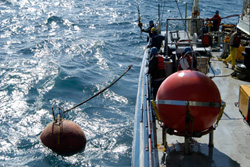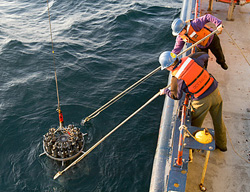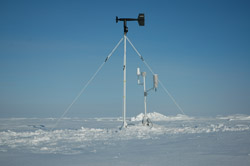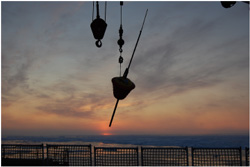On this cruise, the science team is using a variety of tools to make various measurements of the ocean and atmosphere. Some instruments measure only one particular instant in time (CTD, VMP); others collect data over a long time period (instruments on moorings or buoys). Read below to learn about the tools scientists use to probe the cold water of the Arctic Ocean. Instruments Mooring MooringA mooring is an instrument, or series of instruments, attached along a cable that extends over a portion of the water column. A flotation buoy at the top of the mooring keeps the cable taught, and a heavy anchor at the bottom keeps the mooring from moving around. A variety of instruments can be attached to the mooring line; for instance, current meters (which measure the water flow- how fast is it moving?) and temperature/salinity sensors. These instruments collect data at specific time intervals and store the data until the mooring is recovered at a later date.  CTD CTDCTD is an acronym for the parameters that this device measures: "Conductivity (saltiness), Temperature, and Depth." The CTD itself is a set of small probes attached to a large metal rosette wheel (see image). The rosette is lowered on a cable down to the seafloor, and scientists observe the water properties in real time via a conducting cable connecting the CTD to a computer on the ship. The water temperature and salt content, or salinity (which is computed from the conductivity), is important to oceanographers because it tells us about the types of water masses present, and how they are moving in the ocean. There can also be a host of other acessories and instruments attached to the CTD package. These include Niskin bottles (gray bottles in image) which collect water samples at discrete depths for measuring chemical properties, Acoustic Doppler Current Profilers that measure the horizontal velocity, and oxygen sensors that measure the dissolved oxygen content of the water.  Hydrophones and Sonobuoys Hydrophones and SonobuoysThere are three components of the sea bird and marine mammal program.  On-Ice Meteorological Station On-Ice Meteorological StationWe aim to deploy a Polar Area Weather Station (PAWS) on the ice during the cruise. The METOCEAN Polar Area Weather Station (PAWS) is a compact platforms which measures location (through GPS), air temperature, barometric pressure, humidity, sea surface temperature, and wind speed and direction as it drifts with the pack ice. The PAWS has been designed to transmit weather related data on a 3-hour interval over the Iridium satellite network for a period of 1 year.  Drifting buoys Drifting buoysWe will deploy four different types of drifting buoys on the cruise, for other investigators. Last updated: September 28, 2010 | |||||||||||||
Copyright ©2007 Woods Hole Oceanographic Institution, All Rights Reserved, Privacy Policy. | |||||||||||||
